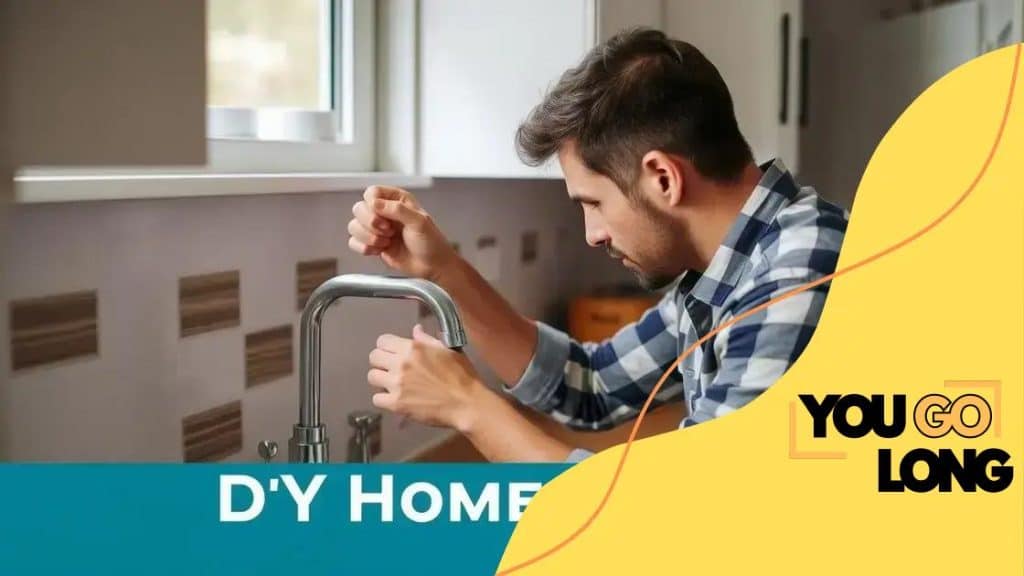DIY home repairs you can do yourself to save money

Advertisement
DIY home repairs you can do yourself to save money include fixing leaky faucets, patching cracks, and improving curb appeal with basic tools and safety precautions, ensuring both cost savings and increased home value.
DIY home repairs you can do yourself to save money are not just about saving cash but also about gaining confidence. Ever thought about fixing that leaky faucet or patching a wall? Let’s explore how you can tackle these tasks with ease.
Essential tools for DIY home repairs
When embarking on DIY home repairs, having the right tools is essential. Each tool has its unique purpose, ensuring you can tackle various tasks efficiently. From fixing leaky faucets to assembling furniture, a well-equipped toolbox can make all the difference.
Basic Tools You’ll Need
To get started, here’s a list of essential tools that every DIY enthusiast should have:
Advertisement
- Screwdrivers: A set of both flathead and Phillips screwdrivers.
- Hammer: A reliable hammer for driving nails and making adjustments.
- Pliers: Useful for gripping, twisting, and cutting wires.
- Tape measure: Essential for accurate measurements when making repairs.
In addition to these basics, there are some advanced tools that can help with more complex projects. For instance, a power drill can save time and effort, and a level is crucial for ensuring everything is straight.
Safety Gear
No list of essential tools would be complete without considering safety. Always prioritize your safety when doing repairs. Invest in:
- Safety glasses: Protect your eyes from debris and dust.
- Work gloves: Keep your hands safe from cuts and blisters.
- Dust masks: Especially important if you’re working with materials that generate dust.
Now that you have the tools and safety gear, you’re ready to dive into the world of DIY home repairs. Each project you complete will not only save you money but also give you a sense of accomplishment. Don’t be afraid to try new things; you might surprise yourself with what you can achieve!
Advertisement
Common household repairs you can tackle
There are many common household repairs that you can tackle yourself. Knowing how to fix simple issues can save you money and give you confidence in your skills. Whether it’s a leaky faucet, a squeaky door, or a cracked wall, these repairs often require minimal tools and effort.
Fixing a Leaky Faucet
A leaky faucet is a common problem that can waste a lot of water. Start by turning off the water supply. Then, remove the handle and use a wrench to tighten any loose parts. If you notice that the washer is worn out, replace it with a new one. This quick fix can help stop the drip and save you on water bills.
Repairing a Squeaky Door
If you have a door that squeaks when opened, it can be annoying. Apply some lubricant to the hinges. Simply spray or wipe the oil, and then open and close the door a few times to work it in. This simple action can eliminate the squeak and make your home quieter.
Patch a Cracked Wall
Cracks in your walls can be an eyesore, but they are easy to repair. Use a putty knife to apply some spackling compound into the crack. Once it dries, sand it down to make it smooth. You can then paint over it to match your wall color. This repair can enhance the overall look of your room.
These are just a few examples of the common household repairs that you can do yourself. Many repairs take only a short amount of time, and you might find that once you start, you’re eager to try more complex projects.
Tips for budgeting your home improvement projects

When taking on home improvement projects, budgeting is essential. A solid budget helps you manage your finances and ensures that you can complete your projects without overspending. Start by determining how much you can afford to spend.
Set a Realistic Budget
Consider all costs involved in your project. This includes materials, labor, and unexpected expenses. It’s wise to add about 10-15% to your total for surprises. This way, you’ll avoid running out of funds halfway through a project.
Research Costs
Before starting, do thorough research on how much materials and services cost. Prices can vary widely. Compare prices at local hardware stores and online. Look for sales or discounts; oftentimes, you can find similar items for less.
- Shop around: Visit multiple stores to compare prices.
- Consider second-hand: Check out thrift stores or online marketplaces for used materials.
- DIY when possible: Doing it yourself can significantly cut costs.
Creating a detailed plan for your home improvement projects is another way to stay on budget. Break down tasks and plan each step carefully. This will help you stay organized and avoid costly mistakes. When you know what you need, it’s easier to keep track of expenses.
Keep Track of Expenses
Document every expense as you go. This will help you see where your money is going and adjust if needed. If you find that you’re deviating from your budget, consider scaling back on non-essential items or finding more affordable alternatives. Keeping a close eye on your spending is critical for staying within your budget.
Using these tips for budgeting your home improvement projects can help you spend wisely and achieve the results you want without breaking the bank.
DIY maintenance to increase home value
Performing DIY maintenance in your home not only keeps it looking good but can also significantly increase its value. Regular upkeep contributes to the overall appeal of your property and can prevent costly repairs in the future. Simple tasks can have a big impact on how potential buyers perceive your home.
Enhancing Curb Appeal
The first impression of your home is crucial. Start by enhancing your curb appeal. Mowing the lawn, trimming hedges, and planting flowers can transform your outdoor space. Consider power washing your driveway and pathways. A clean exterior can make your home feel more inviting.
Regular Painting and Touch-Ups
A fresh coat of paint can revitalize interiors and exteriors alike. Repainting rooms with neutral colors can attract more buyers, as they can easily imagine their own style. Don’t forget the front door! A bright, welcoming color can increase interest in your home.
- Replace hardware: Updating door knobs and cabinet handles can give your space a fresh and modern look.
- Fix leaky faucets: These small repairs show that you take good care of your home.
- Maintain your HVAC system: Regular servicing keeps systems efficient and can be a selling point.
Regularly check your roof and gutters as well. Keeping these maintained prevents larger issues from developing. If you spot issues, take the time to fix them now. A well-maintained home leaves a great impression.
Improving Energy Efficiency
Making your home more energy-efficient is another way to boost its value. Simple upgrades like sealing gaps in windows and doors or adding insulation can make a significant difference. Consider installing energy-efficient appliances that will not only lower your utility bills but are attractive to environmentally-conscious buyers.
By completing these DIY maintenance tasks, you can protect your investment and enhance your home’s value, making it more appealing to future buyers.
Safety precautions when doing repairs at home
When doing repairs at home, prioritizing safety is crucial to prevent accidents and injuries. Knowing the safety precautions can help you complete your DIY projects efficiently and without any mishaps. Start by wearing appropriate safety gear, which includes goggles, gloves, and masks to protect against dust and debris.
Use Proper Tools
Using the right tools for the job can significantly reduce the risk of injury. Ensure you have high-quality tools that are suitable for your projects. For example, using a proper ladder helps prevent falls while doing tasks like changing light bulbs or painting.
Keep Your Workspace Clear
A cluttered workspace can lead to accidents. Before starting any repair, take a moment to organize your tools and materials. Clear away unnecessary items and ensure that there are no tripping hazards in your area. This will help you work more efficiently and safely.
- Check for wires: Before drilling into walls, check for electrical wires or plumbing to avoid accidents.
- Use power tools correctly: Follow the manufacturer’s instructions and never bypass safety features.
- Don’t work alone: Having someone nearby can help in case of emergencies.
Another important aspect is to ensure proper ventilation when using paints or chemicals. Fumes can be harmful, so always work in a well-ventilated area. If you’re using heavy materials, make sure to lift with your legs and not your back to prevent strain injuries.
Be Aware of Your Surroundings
Stay alert to your environment while working. Pay attention to potential hazards like wet floors or unstable surfaces. It’s smart to have a first aid kit readily available for any minor injuries.
By implementing these safety precautions, you can protect yourself and your home, ensuring that your DIY repairs are both successful and safe.
In conclusion, embarking on DIY home repairs can be rewarding, both financially and personally. By understanding safety precautions, having the right tools, and staying organized, you can tackle common repairs with confidence. Remember to budget wisely and seek help when needed. Every small project you complete not only improves your home but also increases its value.
FAQ – Frequently Asked Questions about DIY Home Repairs
What are the essential tools I need for DIY home repairs?
Basic tools include a hammer, screwdrivers, pliers, a tape measure, and safety gear like gloves and goggles.
How can I stay safe while doing repairs at home?
Always wear safety gear, keep your workspace organized, and be aware of your surroundings while working on repairs.
What are some common home repairs I can do myself?
You can fix leaky faucets, patch up cracks in walls, repair squeaky doors, and improve curb appeal with landscaping.
How do I budget for my home improvement projects?
Start by estimating the costs of materials and labor, and add a buffer of about 10-15% for unexpected expenses.





